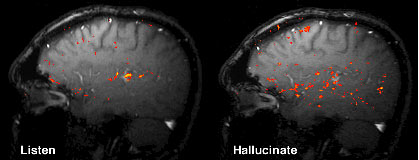Where the Voices Come from: Imaging of Schizophrenic Auditory Hallucinations
M.S. Cohen & M.F. Green. Brain mapping center, UCLA School of Medicine, Los Angeles, CA 90095
Presented at the Society for Neuroscience, 1995
Auditory hallucinations (AH's) are a common concomitant of schizophrenia, occurring in about 70% of patients at any time (1) , usually taking the form of a voice speaking to or about the subject. Though these "voices" certainly must arise internally, the subjective experience is of "hearing" the voice of another. We predicted, as did Cleghorn (2) that a mechanism for the production of AH's may be the activation of cortical pathways of language, either auditory koniocortex or, more likely, the classical receptive speech areas of Wernicke (Brodmann's areas 22 in the superior temporal gyrus, and 39 and 40 in the supramarginal & angular gyri.) To test this hypothesis we performed functional Magnetic Resonance Imaging (fMRI) (3) during spontaneous auditory hallucinations in three subjects under current medical treatment for schizophrenia, collecting one image every seven seconds (TR=70ms/TE=50ms/FA=45 degrees;/128x256/0.75 NEX). During the seven minute scanning period, the subjects indicated the presence of voice-like AH's with a finger. In half of the trials the subjects also listened to audio tapes of voices designed to have manifest content similar to that of the AH's. Pixel-wise statistical (t-test) comparisons of the MR signal intensity during the AH (or direct stimulation) were made with rest images to indicate regions of altered signal. Functional images of direct stimulation showed well-localized activity primarily in the superior temporal gyrus (STG). During the AH's the MR signal was elevated more diffusely in left STG, as well as in left angular gyrus and inferior frontal gyrus. We suggest that it is the activity in primary auditory receptive areas that results in the voice-like quality of AH's and that may differentiate them from ordinary language-based thought.

1. P. D. Slade, R. P. Bentall, Sensory deception: a scientific analysis of hallucination. Johns Hopkins University Press, Baltimore, 1988.
2. J. M. Cleghorn, et al., Am J Psychiatry 149, 1062-9 (1992).
3. K. K. Kwong, et al., Proc Natl Acad Sci U S A 89, 5675-9 (1992).
|

